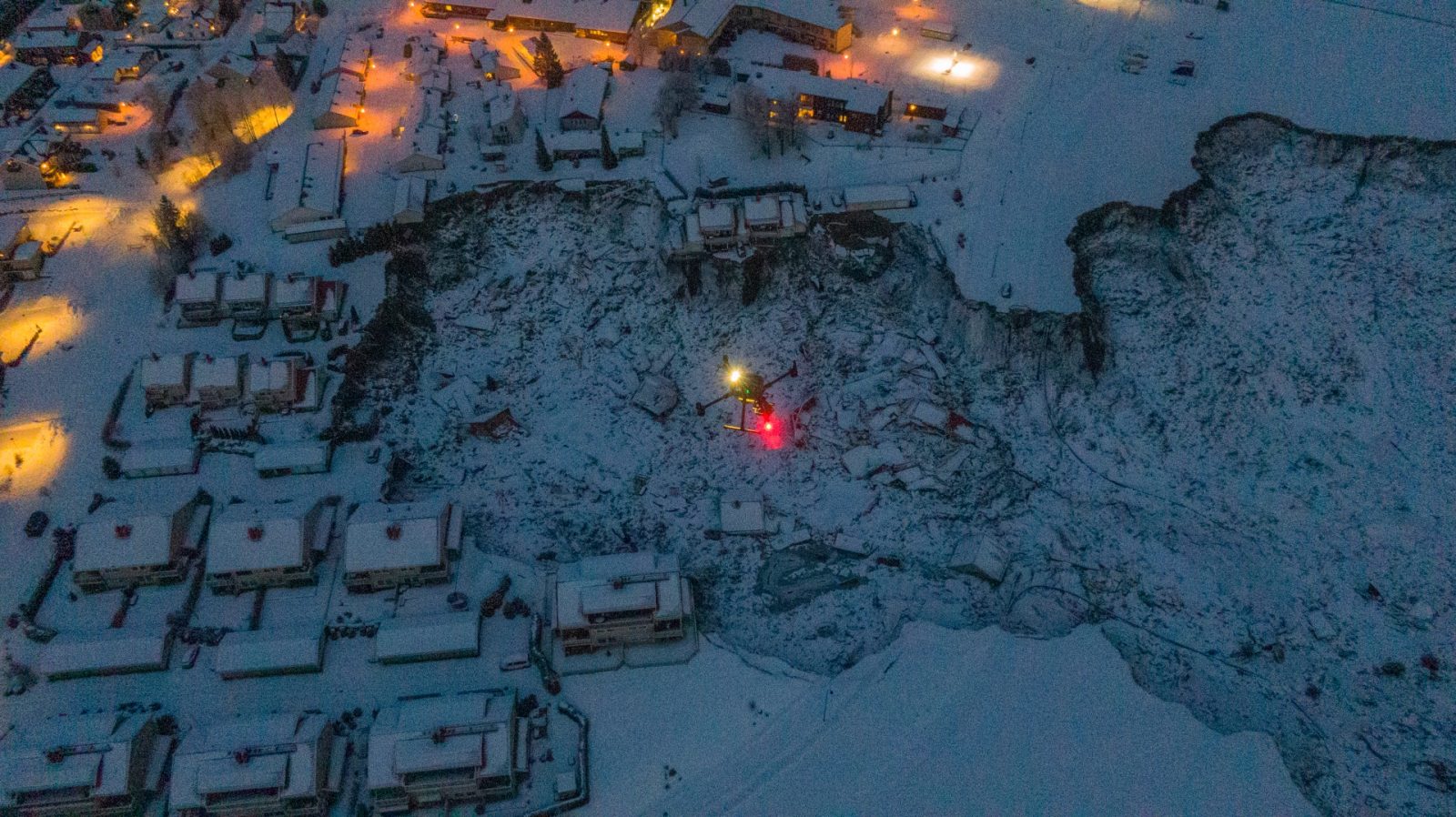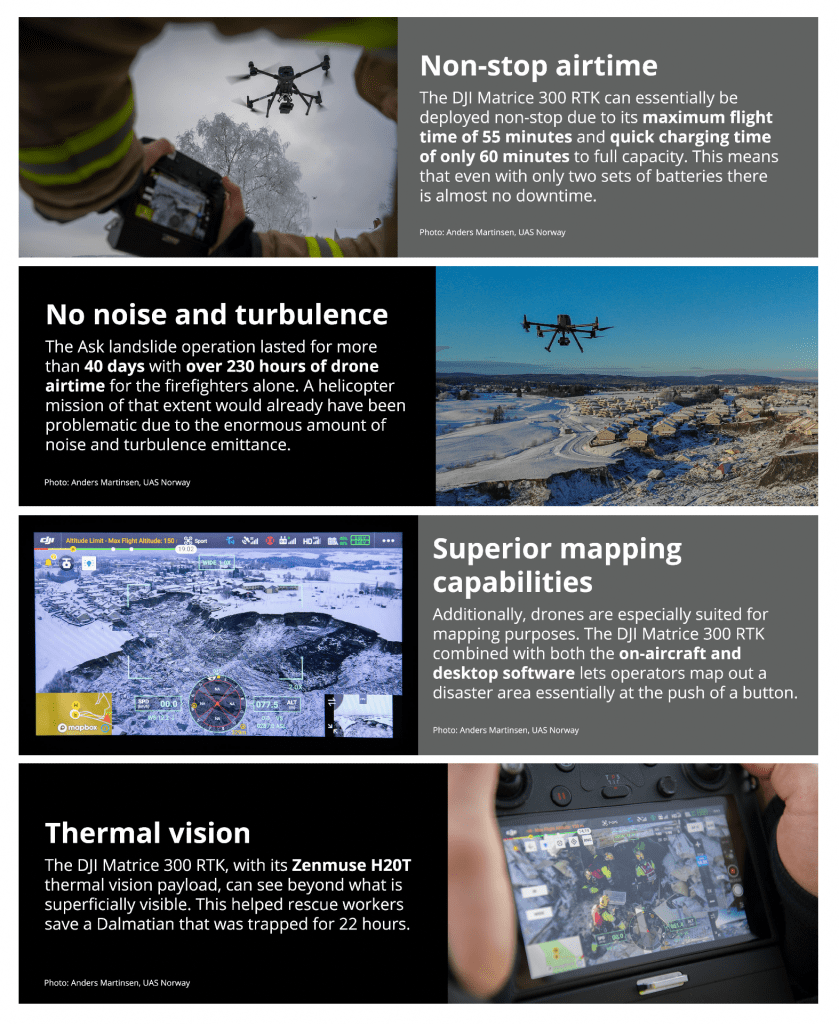
When Norway was struck in the wee hours of December 30, 2020, by the biggest landslide disaster in its history, responders scrambled to launch what wound up becoming a record-setting rescue operation. As they did, powerful surveillance applications of DJI Matrice 300 RTK drones deployed above the area allowed those workers to more effectively locate and save survivors – and at far reduced risk of becoming victims themselves in the process.
Drones take over from choppers
Nothing about the operation was easy – as details DJI alerted DroneDJ to attest. The landslide covered a large, two-square kilometer section in the village of Ask in Gjerdrum. Temperatures dropped to marrow-chilling -23°C lows, and winds gusted up to 18.4 m/s. The alert was called in at 4 a.m. at the time of year when the sun rises after nine and shines a mere six hours. Responders rushing out to look for victims buried under thick, freezing mud or stranded in rubble would not only battle dismal search conditions, but also face great peril to their own safety on unstable terrain.
To avoid that, a careful, fully informed intervention was vital.
Initially, helicopters were flown on search and rescue missions over the slide area during the limited period of daylight. When darkness descended, Norwegian emergency services put their DJI Matrice 300 RTKs drones into action. The craft proved itself the game-changer in an operation that covered 40 days and 270 airtime hours – the longest drone-led rescue effort in Europe thus far.

Super-rapid infrared mapping
The Matrice 300 RTKs became stars of that campaign in a number of ways. For starters, once helicopters vacated the darkened area, the drones began the critical work of mapping it with their Zenmuse H20T thermal vision payloads. Because those infrared images are less dense than traditional photos, the processing time involved was greatly reduced.
Meanwhile, the field of surveying vision is far larger for drones than chopper-borne humans. The Matrice 300 RTKs, therefore, also considerably cut the time needed to shoot sections needed to be stitched into a complete map.
The combined result: a completed 3D map rescue officials could begin working with just one hour after the drones had landed – and a mere five after they’d started the job.
Drones keep rescuers from becoming victims
As rescue efforts progressed, Zenmuse H20T thermal vision also became essential in locating trapped or buried victims from above. Twenty-two hours into the response, for example, the sensor identified the heat signal of a trapped dog, then hovered above the creature – beaming its light on it in the dark – until it could be lifted out by helicopter.
Even then, the drone hadn’t run out of ways to impress its human partners. Its pre-planned fixed flight route capacity allowed officials to compare exact coordinates on the initial maps with those in live video feeds as searches advanced. Differences alerted them to shifts or other changes in the slide zone that might be indicative of dangerously unstable ground or other hidden hazards. Foretold being forewarned, that data permitted rescue workers to prepare for, or avoid, those perilous spots. Satellite images previously used would have been far less detailed, and rapidly out of date.
Oslo police district superintendent Jørgen Lunde Ronge, said the drones were vital to navigating a “unique incident.”
Ensuring everyone has the same understanding of the operation is always important but difficult. Drones helped us with this challenge. Also, they delivered high-quality aerial sensor data to monitor the landslide so we could safely continue the operation at all hours.

Matrice 300 RTKs continue to amaze
Their 55-minute battery life also meant the Matrice 300 RTKs could be flown on extended missions – then subbed by others in the fleet during one-hour recharging periods – in what became quasi-continuous flights throughout the operation. Their deployment above rescuers, meantime, generated none of the cold-intensifying, dust-blasting turbulence of constant helicopter surveillance.
Norwegian emergency officials even found innovative uses for Matrice 300 RTKs that DJI may not have planned on (or too crazy about as a regular occurrence). When the situation called for it, the drones would be used to crash through a window to allow a trailing craft to enter the building and inspect it.
Despite its evident efficiency, don’t try that last move at home – unless you live on a landslide (and like wrecking your drones).
Photos: DJI
FTC: We use income earning auto affiliate links. More.




Comments